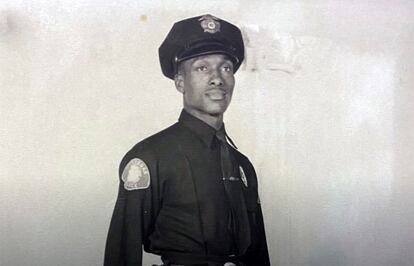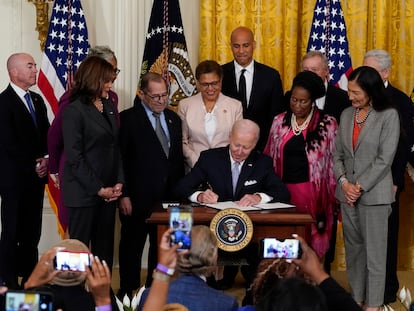First Black Vegas officer role model ‘for people of any color’
Family, friends and police officers will gather Thursday in Las Vegas to remember Herman Moody, who became a police officer in 1946 when the city was still heavily segregated

Las Vegas was still heavily segregated in 1946 when Herman Moody became the city’s first Black police officer. He served for more than three decades in the role, continuing to mentor officers long after he retired in 1977. Moody died Feb. 25 at his home in the Historic Westside, the heart of the city’s Black community near downtown Las Vegas. He was 98.
Family, friends and police officers will gather Thursday in Las Vegas to remember a man they praised as a dedicated lawman, a mentor for “young people of any color” and a man of religious faith.
“I hope he will serve as an icon, an example, a motivating factor for the generations to come,” said Dolores Brown, the eldest of Moody’s five daughters.
The Las Vegas Metropolitan Police Department credits Moody for helping improve policing standards at a time when there was no police academy and Black families were forced to live and work west of the railroad tracks.
Moody was self-taught, reading countless books about Nevada law and the profession. He widely shared what he learned with other officers. But because of the color of his skin, his police work was confined to the Westside, which had dirt roads at the time and no running water or sewage lines.
Nearly eight decades since Moody began his barrier-breaking career, police agencies across the nation are still confronting a lack of diversity amid challenges in recruiting and retaining officers.
About 10% of the Las Vegas police force is Black compared with 56% white. About 12% of the city’s population is Black.
Nationwide, about 17% of officers are Black, according to the US Bureau of Labor Statistics. That figure drops to 5% for police supervisors and detectives. The US population is about 14% Black.
Moody himself was a detective when he retired. But he never reached a higher rank despite his years of seniority and having passed the exams needed to be promoted.
While reflecting on his career in 1976, Moody told the Las Vegas Review-Journal that his supervisors had promoted white officers with less experience over him throughout his career. Moody got the sense that the department’s leadership “was not ready for a Black officer of rank.”
“Since he never got promoted, he wanted to help others be the best cops, the best detectives, the best traffic officers, the best sergeants, lieutenants and chiefs they could be,” said retired Assistant Sheriff Greg McCurdy.
By the time McCurdy joined the police department in 1983, Moody had retired but was still mentoring police officers.
“He laid out a stack of books in front of me when I was a young cop,” McCurdy said, “and he told me, ‘Read these books, and you will be fine.’”
Moody served in the Navy during World War II and aspired to be an engineer before he was recruited to law enforcement by a police inspector who remembered Moody as a high school athlete.
When several more Black officers were hired in Las Vegas, Moody trained them at his home using the same books that taught him how to be a policeman.
Clark County commissioners honored Moody last year for his impact on southern Nevada. Commissioner William McCurdy praised Moody for being a “beacon of light and a role model for young people of any color.”
Moody wore a sweater that read “BLACK EXCELLENCE.” His family told stories of Moody’s love for policing and community, and the importance of reputation.
Moody died in the house he built for his wife, Magnolia, and their daughters – in the same neighborhood as his parent’s home affectionately known as the Moody House. It sits along a trail celebrating the Westside’s history, with a marker recognizing its famous resident.
“Moody insisted that most residents wanted and appreciated good police protection,” the marker reads, “and for thirty-one years he gave it to them.”
Sign up for our weekly newsletter to get more English-language news coverage from EL PAÍS USA Edition
Tu suscripción se está usando en otro dispositivo
¿Quieres añadir otro usuario a tu suscripción?
Si continúas leyendo en este dispositivo, no se podrá leer en el otro.
FlechaTu suscripción se está usando en otro dispositivo y solo puedes acceder a EL PAÍS desde un dispositivo a la vez.
Si quieres compartir tu cuenta, cambia tu suscripción a la modalidad Premium, así podrás añadir otro usuario. Cada uno accederá con su propia cuenta de email, lo que os permitirá personalizar vuestra experiencia en EL PAÍS.
¿Tienes una suscripción de empresa? Accede aquí para contratar más cuentas.
En el caso de no saber quién está usando tu cuenta, te recomendamos cambiar tu contraseña aquí.
Si decides continuar compartiendo tu cuenta, este mensaje se mostrará en tu dispositivo y en el de la otra persona que está usando tu cuenta de forma indefinida, afectando a tu experiencia de lectura. Puedes consultar aquí los términos y condiciones de la suscripción digital.
More information

Justice Department finds pattern of discriminatory policing in Louisville
Archived In
Últimas noticias
Most viewed
- David King, chemist: ‘There are scientists studying how to cool the planet; nobody should stop these experiments from happening’
- Reinhard Genzel, Nobel laureate in physics: ‘One-minute videos will never give you the truth’
- Mexico completes its trade shift with the entry into force of tariffs on China and countries without trade agreements
- Oona Chaplin: ‘I told James Cameron that I was living in a treehouse and starting a permaculture project with a friend’
- Sinaloa Cartel war is taking its toll on Los Chapitos









































